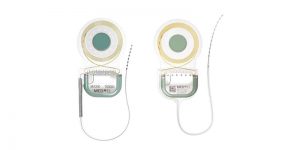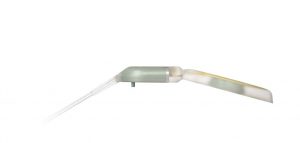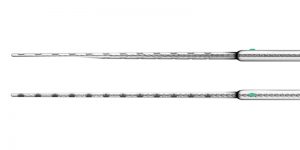MED-EL
Published Oct 16, 2019
3 Reasons Your Surgeon Loves The New SYNCHRONY 2 Cochlear Implant

If you’ve been keeping an eye on the latest MED-EL updates, you may have seen a shiny new implant: SYNCHRONY 2. Our latest cochlear implant combines all the great hearing technology of the original SYNCHRONY implant with a brand-new design, built to make life a little bit easier for your surgeon. Let’s take a look at what SYNCHRONY 2 has to offer.
What’s New With SYNCHRONY 2?
Three new features have been added to SYNCHRONY 2: a central electrode lead, an angled fantail transition, and a green marker dot. Although each of these is only a minor change, for your surgeon, they can make a big difference.
Central Electrode Lead
What is it? If you compare the two images below, you’ll see that the cable coming out of the implant (electrode lead) is in a different position. On SYNCHRONY the electrode lead comes out of the side of the implant housing. On SYNCHRONY 2, it comes out of the center. This is known as a central electrode lead.

Why is it important? Because it helps your surgeon to position your implant more efficiently during surgery. A cochlear implant can be implanted on the left or the right side of your head. But your head isn’t symmetrical, and if the implant also isn’t symmetrical your surgeon may have to think carefully about how they position it on each side. A part of the implant which is on a flat part of your head on the left side may then be on a curved part of your head on the right side.
But if the implant is symmetrical, like SYNCHRONY 2, then the positioning is more similar on both the left and the right sides. This makes surgery a bit more straightforward, which is good news for surgeons.
Angled Fantail Transition
What is it? Now look at this image. Like the original SYNCHRONY implant, the large coil part is angled slightly downwards. But new for SYNCHRONY 2 is the “angled fantail transition”. This is the bottom part of the implant where the electrode comes out, and it’s angled downwards at 30 degrees.

Why is it important? Again, it’s all to do with the shape of your head. Your head isn’t flat, it curves downwards slightly. If your implant is also angled downwards, then it fits the contours of your head better.
What’s more, an angled fantail transition makes it easier to place the electrode lead in a “bony channel”. To protect the electrode lead, your surgeon will drill a small channel going from the implant to your cochlea, and then place the lead inside it. The angled fantail transition, along with a new streamlined electrode lead design, makes this process a lot easier for your surgeon.
Green Marker Dot
What is it? On the picture here you’ll see a little green dot where the electrode lead narrows into the electrode array. As the name might suggest, this is the green marker dot.

Why is it important? Probably the hardest part of the surgery is when your surgeon inserts your electrode array into your cochlea. It’s an incredibly delicate process that involves inserting a tiny wire into a hole that is about a millimeter in diameter. To make things more complicated, how your electrode array is inserted can have a big effect on how well you hear after surgery.
The green marker dot is designed to help your surgeon see how far they have already inserted the electrode array, and therefore know how much more they can insert. That way, your surgeon has more control over the electrode insertion depth, which helps it to be placed correctly in your cochlea.
What Has Stayed The Same?
There were many great things about our groundbreaking SYNCHRONY cochlear implant, which was launched in 2014, and these have been carried over into the SYNCHRONY 2 implant. That means with SYNCHRONY 2 you can still expect:
- Comfortable and safe MRI scans at 3.0 Tesla
- An electrode array that is the ideal fit for your cochlea and that protects it too
- The latest sound coding technology
- A reliable, titanium implant that is one of the smallest available
Want to learn more about SYNCHRONY 2? Check out all the details here.
MED-EL
Was this article helpful?
Thanks for your feedback.
Sign up for newsletter below for more.
Thanks for your feedback.
Please leave your message below.
Thanks for your message. We will reply as soon as possible.
Send us a message
Field is required
John Doe
Field is required
name@mail.com
Field is required
What do you think?
MED-EL


